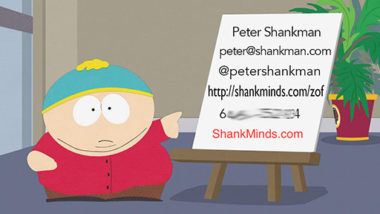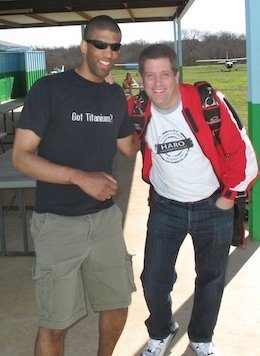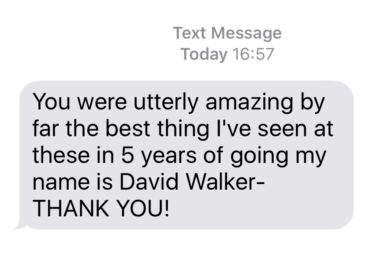I’ve been a paid keynote speaker at conferences and corporate functions all over the world for the past fifteen years, and I’m always amazed by the amount of people who tell me after I’ve spoken that they didn’t expect to enjoy the speech, and were pleasantly surprised at how much they did.
Apparently, the bar is quite low when it comes to audiences listening to people talk from a stage. If you speak publicly in any capacity, this is a great thing for you. All you need to do to rock your next speech, talk, or presentation, is simply to suck a little less than what people expect. Here are five ways to do just that:
5) Stop giving speeches. Start telling stories. People don’t like to be talked at, and they really hate being forced to listen to things to which they can’t relate. So stop giving speeches. Start telling stories. Stories that have four things: Humor, relatability, a point, and an instruction.
For instance, instead of telling people that good customer service has been proven to increase revenues, I show them the same stat with something relevant to them. I tell a story about what it’s like to fly nowadays, complete with references to TSA anal probes, lost luggage, denied boarding, and delayed flights. Who among us can’t relate to that? But then, I finish my story by leading my audience through a scenario where things are better – I have them actually imagining a flight where everything goes right, where they’re upgraded, or even just smiled at by the flight attendants. In this situation, the audience can actually visualize how that feels, and can relate it to their own customers – i.e., how much happier and more loyal their customers will be if they receive a smile or small unexpected hint of civility. When your audience can imagine themselves as players in the story you’re telling, they become an invested audience who wants to hear more.
4) Unless you’re presenting mathematical or scientific figures, ditch the PowerPoint. For real. Can we make a pledge here and now to stop reading to our audience the same words on a big screen they can read themselves? Guess what – You’re no longer speaking – You’re simply providing closed captioning. And no one wants to sit through that.

My “last two minutes of my talk” image.
Instead, have one slide at the end of your talk with your contact information on it. Make it funny, make it memorable, and invite every single audience member to contact you personally if they have any questions about your talk, or want any more information about any of the topics you covered. Not only are you inviting continued communication with your audience, but you’re virtually guaranteeing that they’ll reach out to you, allowing you to start a relationship with them. At the very least, you’ll be doing the one thing that I promise you, no other speaker at the conference has done – You’re being authentic, and nothing goes further to make you memorable than authenticity.
3) Know your audience. Like, really know your audience. This tip might not be for everybody, but it works for me, and I love using it.
I always show up super-early for my speech. If my speaking time is 9:30am, I’ll be at the venue by 7am at the latest. Obviously, I do this first and foremost to make sure I can handle any last minute catastrophes, but more importantly, I have almost two hours to “mingle” with my future audience. But (and here’s the important part,) I don’t mingle as Peter Shankman. Quite the opposite. I mingle as “Jonathan Murrell.” (He’s a skydiving buddy I’ve known for years. I have no idea why I chose his name.)

The real Jonathan Murrell looks nothing like me.
I find the conference organizer, get introduced to the person making the badges at check-in, and ask to have a badge printed with the name Jonathan Murrell, from Arco Logistics. Jonathan has quite the backstory – He’s a senior VP with Arco Logistics (We make international shipping a breeze!) and he’s here to learn from the keynote and the rest of the conference.
So I sit down, (as Jonathan) at a random conference breakfast table, or I just walk around the conference, and start mingling. More to the point, I ask questions. “What are you hoping to get out of the conference? What keeps you up at night? How many customers/clients do you work with?” I’m asking questions left and right and taking note of all the answers, and then refining my keynote speech on the fly! (Hint: I couldn’t do this if I used PowerPoint.) I’m making sure to listen for keywords specific to the company or industry to which I’m speaking, and liberally replace my words with theirs. I’m no longer an outsider talking at my audience, I’m a trusted insider bringing them valuable information from the outside. And that guarantees that my audience will listen to me.
2) Be yourself. That’s what people are there to see. I never wear a tie when I speak. 99% of the time my speaking uniform is a button down shirt, a sport jacket, and jeans. That’s who I am, that’s what I’m about. I don’t fake anything I do, and that includes how I look or speak. How can I possibly expect my audience to believe in me, heck, to even just believe me, if I’m not honest with them from the start?
I speak like I talk. I occasionally curse. (Nowhere near Gary V levels, but the occasional S or f-bomb escapes my lips, especially when I’m excited about a topic.) More importantly, I show my audience right from the start who I am and what I’m about.
My opening lines to any talk I give never change. They are as follows:
“Good morning, (afternoon, evening,) guys. Thank you for having me. We’re going to have some fun here. So you know, I’m @petershankman on all of the socials, and anything I say is tweetable, sharable, postable, you name it. I’m honored that you’d want to share with your audience anything I have to say, so please feel free. And you don’t have to hide your phones or computers, you can do it in the open. I’ve taught at a university. I know when you’re secretly on your phones, because no one ever looks down at their crotch and smiles.”
That right there sets the mood. People laugh, pay attention, and are intrigued. I don’t do any of those “stand up, hug the person to your left,” type exercises, because they’re not genuine. They’re not me. I am who I am. I make no apologies for that.
1) If you do nothing else, remember this: Having an audience is a privilege, not a right. It’s exactly like wearing spandex. I get it. I’m a runner. I’m a triathlete. I know there won’t ever come a day where I have the right to wear those spandex one-piece outfits that you see professional athletes wearing, and I’m ok with that.
It’s the same thing with having an audience. I know that every time someone chooses to listen to me, it’s because I’ve earned that privilege, and I can lose it just as quickly. So I respect my audience. I do my homework, I try to talk to them in a way that helps them learn, improves their lives, and makes them leave with a smile, as well. Focus on doing those three things, and I guarantee, your future speeches will blow away anything you’ve ever done before.
Got some other ideas? I’d love to hear them in the comments! As always, thanks for reading! Oh, and if you highlight anything I’ve wrote, it automatically becomes postable on Twitter or Facebook. Try it!



Great advice. I’ve heard Peter speak and he is indeed great. I consider myself an average speaker but his “suck” scale in pretty decent I guess. I strive to be better at telling stories and to create charts without words as he advises with mixed results.
Excellent points! Peter consistently does a good job paying attention. I’ve been lucky to hear him speak on quite a few occasions and one thing remains the same; when you hire Peter Shankman, you get Peter Shankman. He’s a real guy and that comes through loud and clear. It makes him far more interesting and relevant than many speakers. Great article!
These are all great points! I haven’t done tons of speaking lately, mostly training class so a totally different animal. I am always nervous with the powerpoint…I tend to wander LOL and I worry that folks expect something visual…but I’ll give it a try next month.
Brilliant, thanks Peter.
How is impersonating another person to surreptitiously get information from attendees being authentic and real?
As a keynoter and a workshop facilitator, I have used most of these methods, and they really work. Knowing your audience is KEY! I work in a pretty specialized niche, so I have a good background on most of my clients, but it always helps to chat with participants before you start, then you have an “in” and you have already built credibility for when you take the stage. It also helps to be able to reference that conversation during the program, it creates a huge increase in buy-in.
I’ve been a long time fan of using power point only for pictures or a few important words to support the content. Recently, in smaller groups, I have gotten rid of the PPT completely and went old school with some flip charts. They are great visuals for the room as the day goes on, plus you can use them for engaging activities, unlike PPT. Keep setting the bar high for all of us, Peter!